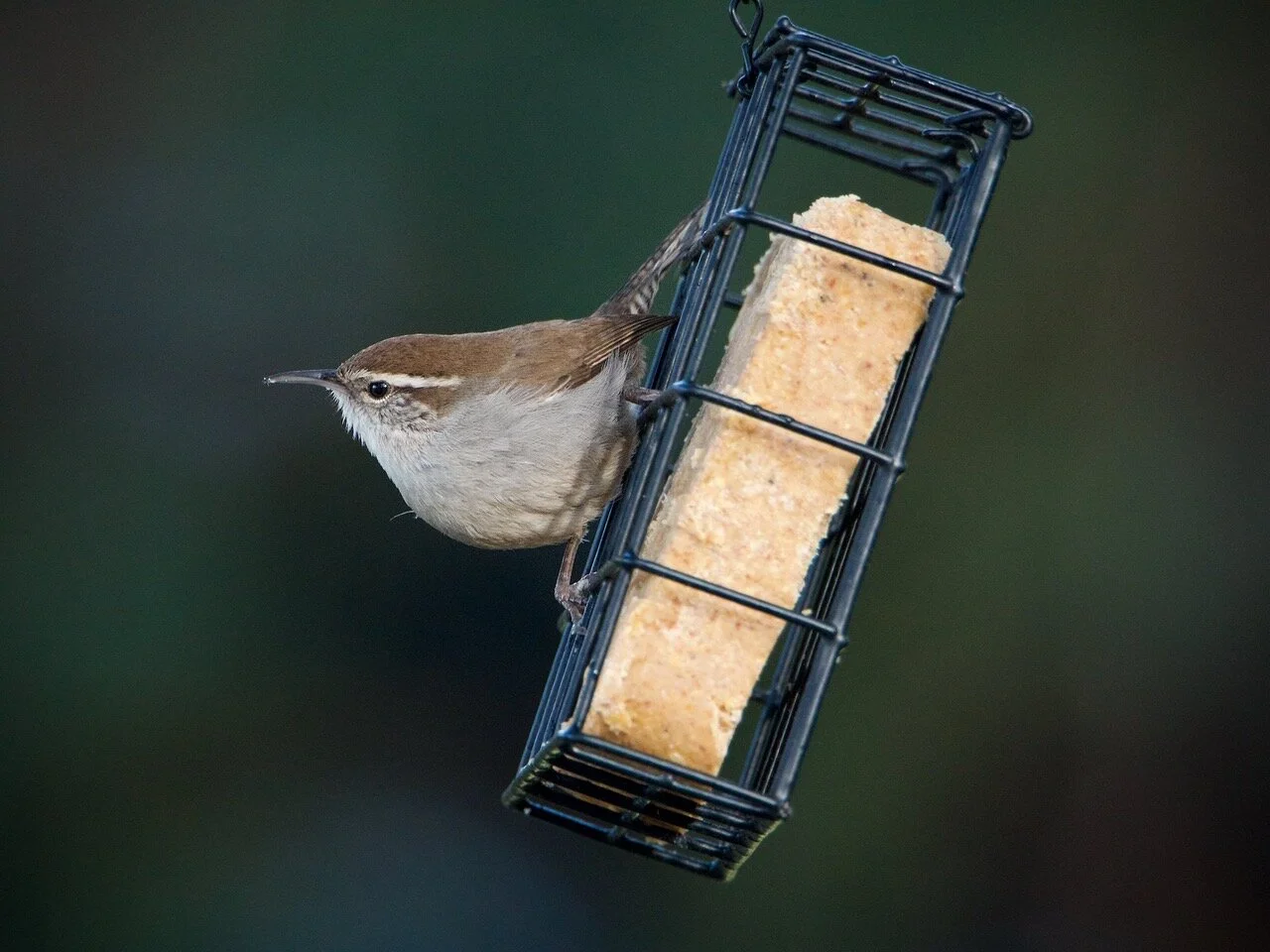Bewick's Wren
Bewick’s Wren
by Dave Zittin
Bewick's Wren is a small, hyperactive bird with an attitude that suggests it is the king of your backyard. It is the most common backyard wren of Santa Clara County. John James Audubon named this wren in the 1820s after his friend Thomas Bewick, who was a British wood engraver and natural history author.
Backyard Bewick’s Wrens
Bewick's Wrens prefer shrubby areas and gravitate to backyards if food is present. Lawn furniture, picnic tables and wood fencing help attract this wren because spiders and insects inhabit these structures. This wren prefers to eat small arthropods and arthropod eggs, but it will feed on suet blocks and seeds, either in feeders or on the ground.
In my backyard, our resident Bewick's Wren is out almost every morning scouting in and around a wood deck for insects, then traveling back and forth between our suet feeder and the seeds I throw on the ground.
Bewick's Wrens may use backyard nesting boxes. See Cornell's NestWatch website for more information.
Bewick’s Wren looking foraging along a rock wall. Photo by Brooke Miller.
Description
A wren is a wren and it's hard to mistake a local wren for a non-wren species based on appearances and behavior. Their perkiness and, for most species, a barred and uplifted tail suggest wren, enabling beginning birders to quickly and accurately realize they are viewing a wren.
Most wrens, including Bewick's Wren, have long beaks that curve downward (decurved beak) and have subtle but beautiful color patterns. Bewick's Wrens have upper parts that are a rich, warm reddish-brown color. The throat and underparts are whitish and the flanks (sides) are gray. The tail has many regularly spaced dark brown cross stripes. The face shows a distinctive bold white eyebrow (supercilium).
Notice the decurved bill, thick white supercilium, and the barred uplifted tail of this Bewick’s Wren. Photo by Dave Zittin.
Sounds
The calls and the songs of the male Bewick's Wren is complex and highly variable. Just when I think I understand their sounds, they seem to invent a new one to throw me off. Only the males sing. They learn their songs from other males on neighboring territories from 60 to 90 days after they fledge, not from their fathers. Individuals can have as many as 22 different songs.
Bewick’s Wrens are just starting to sing in my backyard. A call I often hear is the one I’ve named “the electronic raspberry”, the wren version of a raspberry: bzzzzt. Click on the various calls link near the bottom of the Audubon: Bewick’s Wren page to hear the electronic raspberry. You can hear additional songs and calls on the All About Birds: Bewick’s Wren Sounds page. Our county Bewick's Wren belongs to the "spilurus group", so be sure to listen to the call and song from that group. Note the Geiger counter-like sound of the spilurus group call. This is one of many calls, but I commonly hear this one in my backyard. The spilurus song sample reminds me of a backwards Song Sparrow's song. It starts with a complex beginning with trills and tone changes then ends with 4-5 more or less clear whistle tones.
Singing Bewick’s Wren with plain gray flanks. Photo by Suresh Thirumalai.
Distribution
A century ago, Bewick's Wren was common in the Eastern U.S., but its numbers declined as the House Wren expanded its range. Over the past few decades, once common Bewick's Wren sightings became a rare event east of the Mississippi River. Today this species has a complex distribution that is mostly limited to the west coast along most of Baja California, north to Southwestern British Columbia, and a separate portion of its range over several southwestern states and south into Central Western Mexico (range map).
Bewick’s Wrens have very upright tails which they wave about while giving scolding calls. Photo by Dave Zittin.
Similar Species
Santa Clara County has five common wren species; Bewick's, Marsh, House, Pacific and Rock Wren and a sixth uncommon species, the Canyon Wren. When viewing a local wren, examine the face to see if a conspicuous white eyebrow (supercilium) is present. Besides the Bewick’s Wren, there are two other wren species in the county that have superciliums, the Pacific and the Marsh Wren. But neither of these birds will likely be found in suburban backyards because of their unique habitat preferences and their eyebrows are pale and relatively inconspicuous compared to that of a Bewick’s Wren.
Explore
Other local wren species with eyebrows (superciliums)
NestWatch Sites
Sounds and Calls
All About Birds: Bewick’s Wren Sounds
Audubon Field Guide: Bewick’s Wren
More Backyard Bird Information
View more common Santa Clara County Backyard Birds
Visit our Backyard Birding page
Read our Notes and Tips from a Backyard Birder series
Tell us what you’re seeing in your yard! Send your notes, photos, and sound clips to backyardbirds@scvas.org. We’ll feature your submittals on our website.
Banner Photo by Curt Bianchi





